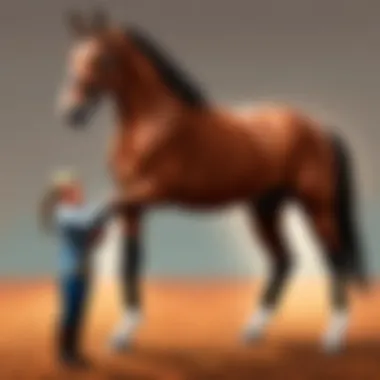Unlocking the Art of Taming a Wild Horse: A Comprehensive Guide


Horse Training Techniques
Breaking a horse requires a deep understanding of their behavior and natural instincts. Before commencing the training process, it is crucial to establish a bond of trust and respect with the wild horse. This involves spending time observing their movements, interactions, and reactions to various stimuli in their environment. By gaining insight into the horse's thought processes and modes of communication, trainers can develop a personalized approach to building a connection based on mutual understanding.
Developing Trust and Respect
Building trust with a wild horse is a gradual and delicate process that demands patience and consistency. Whether through groundwork exercises, grooming sessions, or basic obedience training, every interaction contributes to nurturing a strong foundation of trust. By respecting the horse's boundaries and responding to their cues with sensitivity and understanding, trainers can earn the animal's confidence and cooperation.
Working with Horse Behavior
Understanding horse behavior is fundamental to successful training. By deciphering the meaning behind their gestures, vocalizations, and body language, trainers can anticipate the horse's reactions and adapt their training techniques accordingly. Recognizing signs of stress, fear, or discomfort enables trainers to modify their approach and create a safe learning environment conducive to the horse's well-being.
Positive Reinforcement Techniques
Incorporating positive reinforcement techniques into training sessions can accelerate the learning process and foster a bond of trust. Rewarding desired behaviors with treats, praise, or physical affection reinforces the horse's understanding of expectations and encourages future compliance. By emphasizing positive experiences and associations, trainers can motivate the horse to engage actively in the training process and establish a harmonious relationship based on mutual respect and appreciation.
Introduction
In this segment of the extensive guide on Breaking a Horse, we delve into the fundamental importance of understanding horse behavior. Aspiring equestrians and seasoned trainers alike will benefit from exploring the intricate methods, techniques, and considerations involved in training wild horses for domestication. From decoding equine psychology to building trust and respect, this guide offers invaluable insights to navigate the challenging yet rewarding journey of breaking a horse.
Understanding Horse Behavior
The Importance of Equine Psychology
When it comes to breaking a horse, delving into equine psychology is paramount. Understanding the mental and emotional workings of horses plays a pivotal role in successful training. Equine psychology sheds light on how horses perceive and respond to their environment, making it a cornerstone of effective communication and relationship-building. By grasping the intricacies of equine psychology, trainers can tailor their approach to individual horses, fostering a deeper connection and enhancing training outcomes.
Instinctual Responses in Wild Horses
Exploring the instinctual responses exhibited by wild horses is key to comprehending their behavior during the breaking process. Wild horses have evolved sophisticated survival instincts honed over generations, impacting their reactions to various stimuli. By dissecting these instinctual responses, trainers can anticipate and address behaviors rooted in natural survival mechanisms, guiding wild horses towards a more domesticated demeanor. Recognizing and modifying these innate responses are crucial steps in the journey of breaking a horse.
Communication through Body Language
One of the most vital aspects of understanding horse behavior lies in deciphering their communication through body language. Horses convey a plethora of information through subtle cues, gestures, and postures, forming the backbone of their social interactions and responses. By honing the skill of interpreting horse body language, trainers can establish rapport, convey cues effectively, and establish trust with their equine partners. Mastering the art of communication through body language enhances the trainer-horse relationship, laying a solid foundation for successful training.
Preparation for Breaking a Horse
Evaluating the Horse's Physical Condition
Prior to embarking on the breaking process, assessing the physical condition of the horse is imperative. Evaluating factors such as overall health, fitness level, and any potential physical limitations is essential to tailor the training regimen effectively. By understanding the horse's physical condition, trainers can devise a training plan that promotes health, well-being, and optimal performance, setting the stage for a successful breaking journey.
Gathering the Necessary Equipment


Equipping oneself with the essential tools and gear is a crucial step in preparing to break a horse. From bridles and saddles to grooming supplies and protective gear, having the right equipment ensures a safe and effective training environment. Each piece of equipment serves a specific purpose in the breaking process, aiding in communication, comfort, and safety for both the trainer and the horse. Gathering the necessary equipment is not just about readiness but also about prioritizing the welfare and success of the horse during training.
Creating a Safe Training Environment
Establishing a safe and conducive training environment is fundamental to the breaking process. A well-designed training space free of hazards and distractions cultivates a sense of security and focus for the horse, enabling effective learning and progress. Creating clear boundaries and designated areas for different training activities fosters consistency and organization, laying the groundwork for structured and productive training sessions. A safe training environment is not only essential for the horse's physical well-being but also contributes to building trust and confidence throughout the breaking journey.
Establishing Trust and Respect
Building a Bond with the Horse
Building a strong bond with the horse forms the cornerstone of trust and respect in the breaking process. Establishing a positive relationship based on communication, respect, and mutual understanding lays the foundation for a harmonious partnership. By investing time and effort in building a bond, trainers cultivate trust, loyalty, and cooperation in their equine companions, enhancing the training experience and forging a lasting connection.
Developing Mutual Understanding
Developing mutual understanding between the trainer and the horse is a dynamic process that fosters clear communication and empathy. By tuning into the horse's cues, responses, and preferences, trainers can adapt their approach to meet the horse's needs effectively. Mutual understanding enhances the trainer-horse relationship, leading to smoother training sessions, improved cooperation, and stronger bonding. Through patience, observation, and empathy, trainers can bridge the communication gap and establish a profound connection with their equine partners.
Setting Clear Boundaries and Expectations
Setting clear boundaries and expectations is essential in establishing a structured and disciplined training environment. Clearly defining rules, commands, and behavioral expectations provides clarity and consistency for the horse, guiding their responses and actions. By setting boundaries firmly yet fairly, trainers communicate expectations clearly, aiding in the horse's learning process and behavior modification. Consistent reinforcement of boundaries cultivates respect, discipline, and reliability in the horse, contributing to a productive and respectful training dynamic.
Training Techniques
In this article, exploring the section on Training Techniques is imperative for those interested in breaking a horse comprehensively. Training Techniques play a crucial role in preparing a wild horse for domestication by focusing on key elements such as groundwork exercises, desensitization, and saddle breaking. Understanding and implementing the right training techniques can lead to a successful and harmonious relationship between the horse and the trainer.
Groundwork Exercises
Leading and Lunging Exercises
Discussing Leading and Lunging Exercises sheds light on their significance in horse training. These exercises contribute to developing essential skills in the horse, such as responsiveness to cues and building trust with the trainer. The key characteristic of Leading and Lunging Exercises lies in establishing a foundation of communication and respect between the horse and the handler. This exercise is favored in this article due to its effectiveness in fostering a strong bond and improving the horse's obedience. While Leading and Lunging Exercises are beneficial for enhancing communication, they may require patience and consistency to yield desired results.
Desensitization to Tack and Equipment
Exploring Desensitization to Tack and Equipment reveals its pivotal role in preparing a horse for wearing saddles and bridles. This process involves exposing the horse to various equipment to reduce fear and anxiety related to unfamiliar objects. The main characteristic of Desensitization to Tack and Equipment is its ability to accustom the horse to different tactile stimuli, ensuring a smooth transition to carrying a rider. This method is widely utilized in this article because it helps instill confidence in horses and minimizes potential resistance during the breaking process. While Desensitization to Tack and Equipment is valuable, it requires careful observation and consideration of the horse's reactions to prevent overwhelming or scaring the animal.
Teaching Basic Commands
Delving into Teaching Basic Commands emphasizes its role in establishing communication and control during training. Teaching Basic Commands focuses on instructing the horse to respond to verbal and physical cues, laying the foundation for more advanced training techniques. The key characteristic of Teaching Basic Commands is its simplicity and effectiveness in teaching the horse essential commands for riding and handling. This approach is highly regarded in this article for its ability to create a common language between the horse and the handler. While Teaching Basic Commands is advantageous for building a solid training framework, consistent reinforcement and practice are necessary for mastery.
Desensitization and Exposure
Introducing Sights and Sounds


The incorporation of Introducing Sights and Sounds is crucial for familiarizing the horse with potential environmental stimuli. This phase exposes the horse to various visual and auditory triggers to reduce reactivity and fear responses in unfamiliar situations. The primary feature of Introducing Sights and Sounds is its practicality in acclimating the horse to the sensory experiences it may encounter in different settings. This method is favored in this article for its ability to enhance the horse's adaptability and confidence in novel environments. Although Introducing Sights and Sounds is advantageous for preparing the horse for diverse scenarios, gradual exposure and positive reinforcement are essential to prevent overwhelming the animal.
Environmental Training
Discussing Environmental Training highlights its role in instilling confidence and resilience in horses when facing different surroundings. Environmental Training involves exposing the horse to various settings and obstacles to improve its problem-solving skills and demeanor in unfamiliar environments. The key characteristic of Environmental Training is its emphasis on simulating real-world scenarios to enhance the horse's adaptability and responsiveness to external stimuli. This training method is considered significant in this article for its effectiveness in building the horse's mental and physical preparedness for unforeseen challenges. While Environmental Training is beneficial for enhancing the horse's confidence, gradual progression and positive reinforcement are essential to prevent stress or anxiety.
Handling Unexpected Situations
Exploring Handling Unexpected Situations underlines its importance in equipping the horse with the ability to remain calm and responsive in unpredictable circumstances. This aspect of training focuses on teaching the horse to maintain composure and follow cues when faced with unexpected events or disturbances. The key characteristic of Handling Unexpected Situations is its role in enhancing the horse's adaptability and trust in the handler's guidance during unforeseen incidents. This practice is valued in this article for its contribution to developing the horse's problem-solving skills and maintaining control in challenging situations. While Handling Unexpected Situations is valuable for building the horse's resilience, consistency and positive reinforcement are essential for reinforcing desired behaviors.
Saddle Breaking
Introduction to Saddle and Bridle
Exploring Introduction to Saddle and Bridle elucidates its significance in adapting the horse to the gear required for riding. This stage involves introducing the horse to saddles and bridles to accustom it to the sensation of wearing tack. The key characteristic of Introduction to Saddle and Bridle is its role in preparing the horse for the physical and mental demands of carrying a rider. This method is favored in this article for its effectiveness in familiarizing the horse with riding equipment and establishing a positive association with the riding experience. While Introduction to Saddle and Bridle is essential for transitioning the horse to riding, patience and gradual progression are crucial to ensure the horse's comfort and cooperation.
Gradual Introduction to Riding
Understanding Gradual Introduction to Riding emphasizes the importance of slowly introducing the horse to the experience of being ridden. This process involves progressively acclimating the horse to carrying a rider, focusing on building trust and responsiveness to rider cues. The key characteristic of Gradual Introduction to Riding lies in prioritizing the horse's comfort and confidence throughout the riding initiation process. This approach is highly regarded in this article for its emphasis on establishing a positive riding foundation and preventing anxiety or resistance in the horse. While Gradual Introduction to Riding is essential for introducing the horse to riding, consistency and attunement to the horse's signals are vital for a successful transition.
Teaching Response to Rider Cues
Examining Teaching Response to Rider Cues underlines its significance in refining the horse's ability to understand and obey rider commands. This aspect of training concentrates on teaching the horse to interpret subtle cues from the rider for direction and speed adjustments. The key characteristic of Teaching Response to Rider Cues is its role in fostering clear communication and partnership between the horse and the rider. This practice is highly valued in this article for its contribution to enhancing the horse's responsiveness and adaptability under saddle. While Teaching Response to Rider Cues is fundamental for effective riding communication, consistent practice and reinforcement are essential for reinforcing proper responses and building trust between the horse and the rider.
Challenges and Considerations
When it comes to breaking a horse, understanding the challenges and considerations is paramount. This section delves into the complexities that trainers may face during the breaking process. It emphasizes the importance of being aware of the potential resistance that horses can exhibit and the considerations required to ensure a successful training journey. By highlighting common challenges and providing insights into how to navigate them, this section equips equestrians with the knowledge needed to handle various situations.
Dealing with Resistance
Understanding Fear and Anxiety in Horses
In the realm of dealing with resistance, honing in on understanding fear and anxiety in horses is crucial. This aspect sheds light on the psychological aspects that can impede training progress. By grasping the root causes of fear and anxiety in horses, trainers can tailor their approaches to alleviate these issues. The key characteristic of understanding fear and anxiety is its ability to enhance the trainer's empathy towards the horse's mental state, fostering a more empathetic and effective training environment.
Overcoming Behavioral Issues
Navigating through overcoming behavioral issues plays a vital role in ensuring a harmonious training process. By addressing behavioral challenges head-on, trainers can transform obstacles into opportunities for growth. The distinctive feature of overcoming behavioral issues lies in its capacity to strengthen the bond between the horse and the trainer through patience and consistent training methods. While it may pose challenges, overcoming behavioral issues ultimately paves the way for a more profound connection and smoother training progression.
Patience and Persistence in Training
The cornerstone of successful horse training revolves around the principles of patience and persistence. This aspect underscores the significance of perseverance and the willingness to work through setbacks. Patience and persistence in training not only cultivate a disciplined approach but also instil a sense of resilience in both the trainer and the horse. Despite potential hurdles, embracing the virtues of patience and persistence ultimately leads to rewarding outcomes in the training journey.


Physical Care and Health
Amid the training regimen, prioritizing the physical care and health of the horse is non-negotiable. This section underscores the importance of monitoring physical stress, scheduling regular veterinary check-ups, and considering nutritional needs to promote the horse's well-being. By providing a holistic approach to physical care, trainers can ensure the horse's optimal health and performance throughout the training process.
Monitoring Physical Stress
Keeping a watchful eye on the horse's physical stress is indispensable in maintaining its overall well-being. By monitoring signs of strain or fatigue, trainers can adjust training intensity accordingly, preventing injuries or exhaustion. The key characteristic of monitoring physical stress lies in its proactive approach, allowing trainers to address issues before they escalate and affect the horse's training progress.
Regular Veterinary Check-ups
Integrating regular veterinary check-ups into the training routine is key to safeguarding the horse's health. Routine examinations enable early detection of potential health issues, ensuring prompt intervention and treatment. The unique feature of regular veterinary check-ups lies in their role as preventive measures, promoting the horse's longevity and overall fitness. By prioritizing regular check-ups, trainers demonstrate a commitment to the horse's well-being.
Nutritional Considerations
Addressing the horse's nutritional needs forms a critical component of its care regimen. By tailoring a balanced diet that meets the horse's requirements, trainers can support its physical development and performance. The significance of nutritional considerations stems from their direct impact on the horse's energy levels, muscle growth, and overall health. By fine-tuning the horse's diet based on its unique needs, trainers can optimize its training results and well-being.
Continued Training and Development
Beyond the initial training phase, continued training and development pave the way for ongoing growth and skill enhancement. This section explores advanced training techniques, specialized disciplines, and the importance of building a lifelong partnership with the horse. By progressing beyond the basics, trainers can unlock new avenues for skill refinement and deepen their bond with the horse.
Advanced Training Techniques
Delving into advanced training techniques introduces a higher level of skill mastery and refinement in the training process. By incorporating advanced methods, trainers can challenge the horse to reach new performance heights and expand its capabilities. The key characteristic of advanced training techniques lies in their ability to stimulate the horse's cognitive and physical abilities, fostering continual growth and development.
Specialized Disciplines
Exploring specialized disciplines offers trainers the opportunity to delve into specific areas of equestrianism, catering to individual interests and goals. By honing skills in specialized disciplines such as dressage or show jumping, trainers can refine their expertise and engage in competitive or recreational pursuits. The unique feature of specialized disciplines is their tailored approach, allowing trainers to focus on particular areas of interest and expertise.
Building a Lifelong Partnership
Central to successful horse training is the cultivation of a lifelong partnership between the horse and the trainer. This aspect emphasizes the enduring bond that forms through mutual trust, respect, and shared experiences. The significance of building a lifelong partnership lies in the depth of connection and understanding that develops over time, transcending routine training to establish a profound companionship. By fostering a lifelong partnership, trainers embark on a journey of mutual growth, learning, and companionship with their equine counterparts.
Conclusion
Breaking a Horse remains a pivotal stage in a horse training process. As we wrap up this comprehensive guide, it's essential to reflect on the journey while highlighting crucial elements like establishing trust, groundwork exercises, and continued learning. This section encapsulates the essence of the entire guide, emphasizing the significance of patience, consistency, and understanding in developing a strong bond with the horse.
Final Thoughts on Breaking a Horse
Reflecting on the Training Journey
Reflecting on the Training Journey plays a fundamental role in evaluating progress and understanding the horse's responses to training techniques. By introspecting on the challenges faced and milestones achieved, trainers can refine their methods and approaches. This reflective practice fosters a deeper connection between the trainer and the horse, promoting mutual trust and respect. While it requires time and dedication, reflecting on the training journey is a rewardingly introspective process that enhances the training experience.
Embracing the Partnership with the Horse
Embracing the Partnership with the Horse signifies a shift towards collaborative and harmonious interaction between the trainer and the horse. This step marks the transition from authoritative training methods to a cooperative partnership based on communication and empathy. By acknowledging the horse as a sentient being with emotions and personality, trainers can cultivate a profound bond built on understanding and mutual benefit. Embracing this partnership fosters a positive training environment and enables both parties to grow and learn together, creating a lasting and fulfilling relationship.
Continued Learning and Growth
Continued Learning and Growth are perpetual processes essential for effective horse training. Through ongoing education, trainers can explore advanced techniques, refine their skills, and adapt to the evolving needs of the horse. This commitment to learning demonstrates a dedication to providing the best care and training for the horse, ensuring their physical and emotional well-being. By remaining open to new knowledge and experiences, trainers can enhance their communication with the horse, deepen their bond, and achieve new levels of harmony and success in their partnership.



